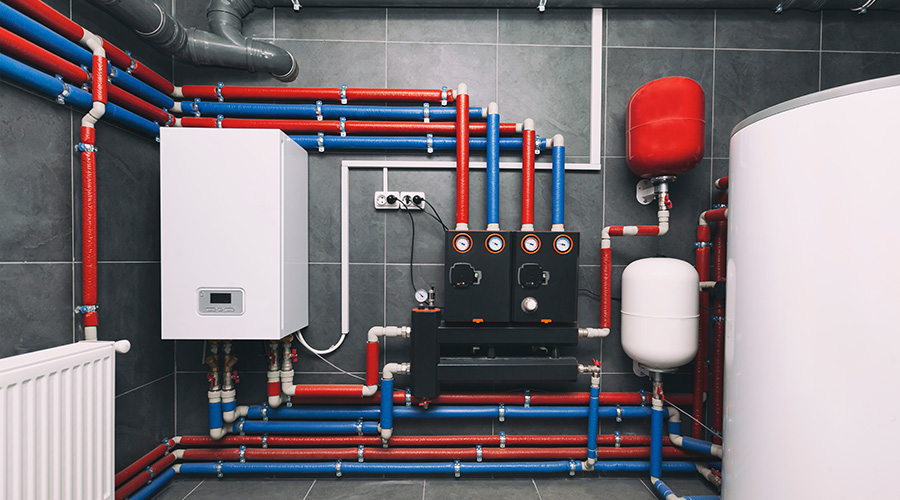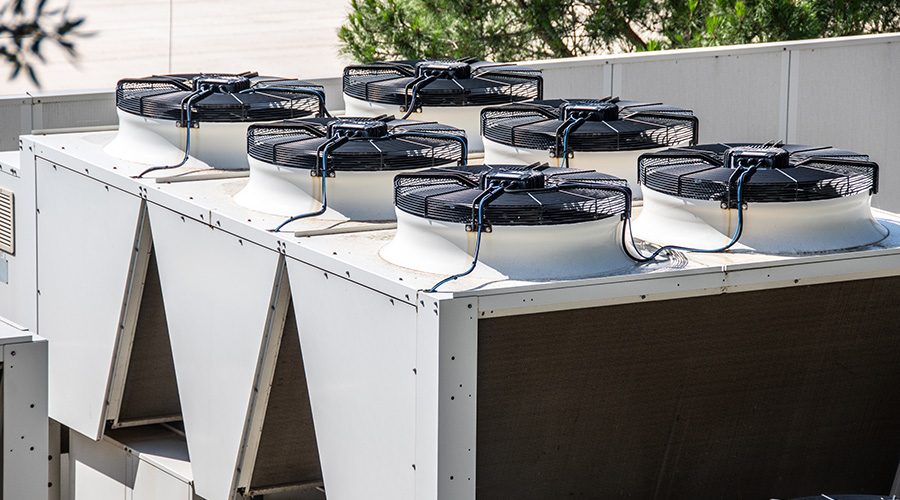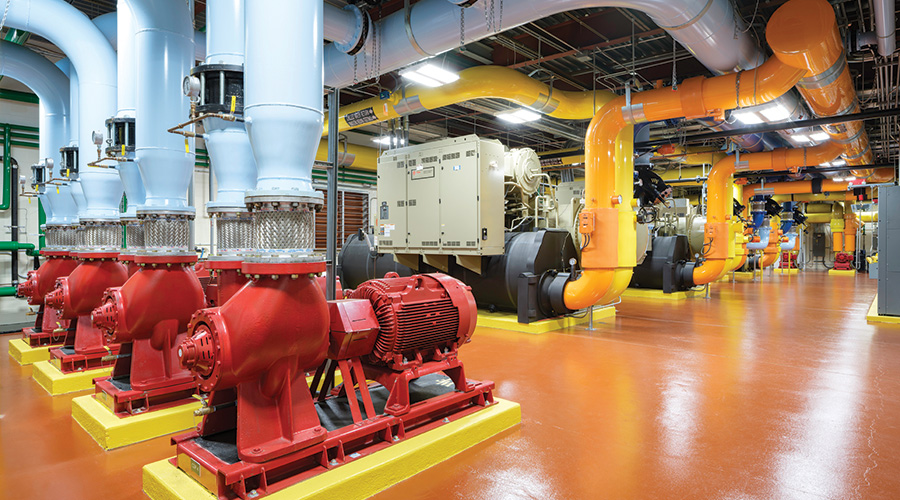HVAC
The New Realities of HVAC Design
HVAC systems have been rapidly growing more complex, thanks in part to new factors to the equation. Today’s systems are expected to meet changing heating and air conditioning needs, while performing at higher levels of energy efficiency than systems installed as recently as 10 years ago. At the same time, they must meet new standards for indoor air quality and communicate with other building systems.
The equation has become even more complex with the recognition of the role HVAC systems play in protecting the health and safety of the building occupants. Aware of system vulnerabilities, facility executives are striving to protect facilities and occupants from the threat of chemical and biological threats, whether accidental or intentional.
The challenge to system designers and facility executives is achieving goals for improved system performance, efficiency and security without making systems unaffordable or unmanageable. At first glance, the challenge may seem tough enough in new system design, and overwhelming in retrofit applications. Fortunately there are options that allow facility executives to reach many of these goals, and to do so without breaking the bank or creating systems that cannot be maintained.
Energy Efficiency
The energy efficiency of HVAC systems and equipment has been improving steadily for many years.
New-generation chillers offer peak operating efficiencies that are 25 percent higher than those of only 10 or 15 years ago. Even higher annual operating efficiencies can be achieved by adding variable frequency drives to both older and new-generation chillers.
Similar improvements in operating efficiency can be achieved with boiler systems. New condensing boilers offer an operating efficiency of about 92 percent, as opposed to 75 to 85 percent for older units. On an annual basis, this improvement in operating efficiency reduces energy use by 20 to 25 percent.
Further improvements in boiler operating efficiency can be achieved by adding such features as oxygen trim controls and economizers. Conventional boiler controls are set to provide 10 to 20 percent excess combustion air to eliminate the generation of smoke under a wide range of boiler loads. Oxygen trim controls allow clean operation of the boilers with as little as 5 percent excess air, significantly increasing the boiler’s operating efficiency.
One way to improve boiler efficiency is to use a modulating control. Conventional boiler controls shut down the boiler for a short period of time when the load is satisfied. As pressure and temperature fall in the system, the boiler fires. This cycling of the boiler reduces overall operating efficiency. In contrast, modulating boilers automatically vary boiler firing to match the load. This typically results in an increase in annual operating efficiency of approximately 10 percent over conventional boilers.
Economizers can be used to recover heat from the flue gas and transfer it to the boiler feed water, raising the overall operating efficiency. As a rule of thumb, for every 10-degree Fahrenheit increase in feed water temperature, boiler efficiency is improved by 1 percent.
Energy efficiency can also be improved by careful selection of electric motors used in pump and fan systems. Motor efficiency has steadily been improving. While high-efficiency motors are more costly than standard efficiency ones, the additional first costs can typically be recovered in one to two years.
Matching the Load
One of the most significant changes in HVAC system design practice today is right sizing. In the past, it was accepted practice to calculate the loads that the system would have to meet, then add anywhere from 20 to 50 percent additional capacity. Several factors combined to make this the long-accepted practice.
One factor was that load estimates used in sizing equipment were just that — estimates. Without today’s modeling tools, it was too time-consuming to calculate loads more accurately. Designers would use rules of thumb, then round the numbers upward.
Another factor was the belief that additional capacity provided flexibility. Oversizing systems was intended to offer spare capacity in the event of changes to operations within the building. In practice, however, changes in operations either had little impact on total building loads, or they were so significant that additional or specialized systems had to be installed anyway. The result was that the spare capacity was rarely needed.
Designers also liked to build in a safety factor for system deterioration over time. As dirt accumulated on fan blades or within ductwork, it reduced the possible airflow through the system. Similarly, scaling and corrosion within boilers, chillers and heat exchangers reduced the efficiency and capacity of the equipment. To compensate for these losses, designers simply increased the size of the components.
Targeting Peak Efficiency
While having some additional capacity is a necessity, 20 to 50 percent spare capacity is rarely advisable. The additional capacity increases installation and maintenance costs without providing any benefit. Even worse, oversizing in almost all applications decreases operating efficiency. Practically all HVAC equipment operates at its peak efficiency at or near its full-load rating. Operating under part-load conditions can significantly reduce this efficiency.
Consider a new centrifugal chiller that has a full-load rated efficiency of .50 kilowatts per ton and does not have a variable frequency drive. At 75 percent of full load, that operating efficiency falls to anywhere from .70 to .80 kw per ton. At 50 percent of full load, it can be as low as 1.0 kw per ton. While the load on the chiller will vary based on the time of day and the season, oversizing the chiller will only further reduce its seasonal operating efficiency.
The same loss of efficiency applies to boilers. Boilers operate at peak efficiency over a fairly narrow operating range. Oversized boilers typically throttle back or cycle — actions that will reduce their operating efficiency. Accurate control systems can help, but they cannot fully compensate for oversized systems.
In applications where the boiler is to be replaced, an option is to install multiple smaller boilers instead of a single large unit. By using multiple small boilers, facility executives can stage their operation to closely match the load on the boiler over a much wider range of loads, improving overall operating efficiency. Multiple small boilers also provide facility executives with several levels of backup in the event of a failure of one of the units.
Interoperability Gains
The traditional design approach to HVAC systems has been to design each building system or subsystem in isolation. With the exception of how heating and cooling loads were affected, HVAC systems were designed and operated independently from lighting and security systems. The result was a collection of independent systems that could not even communicate with each other.
Although this approach using independent systems did provide facility executives with tools to operate their facilities, it did not take into consideration the fact that many of the functions performed by separate systems are highly interrelated. Actions taken by one system can have a major impact on the operation of other systems.
The development of interoperable building systems has reduced the barriers erected by independent building systems. In an interoperable system, any data created anywhere in the system is available for use by any other system or component in the system. This ability to share and make use of data that was previously unavailable allows more efficient and effective operations.
For example, an access control system can track and identify occupancy levels in different areas within a building. Changes in occupancy levels affect HVAC loads and the need to introduce outdoor air into the facility. By using information from the access control system, an interoperable system can vary the quantity of outdoor air introduced as needed, reducing energy requirements.
Interoperable systems are available today. They are more difficult and often more expensive to install than conventional independent systems. Their return, however, affects practically every aspect of building operation. Performance, reliability, efficiency, flexibility — all will be enhanced through the operation of an interoperable system. Before dismissing interoperability, facility executives should carefully consider its advantages. Decisions made concerning interoperability during the design process will have to be lived with for a long time.
Security Considerations
The risk of terrorist attacks has made protecting building occupants from airborne chemical or biological attacks a priority. The focus is not only on intentional acts designed to harm occupants; it extends to minimizing health and safety threats from accidental incidents. While the chances of either taking place in most buildings is still considered to be low, facility executives may choose to take preventive steps based on a risk analysis.
Improving HVAC system security poses some significant challenges. HVAC systems distribute air rapidly within a facility. The accidental or deliberate release of a contaminant must be detected and acted upon quickly if the exposure of building occupants is to be minimized.
Another problem is that there is no device that can be readily installed in or near building HVAC systems that can detect all critical chemical and biological agents.
Prevention is Key
Making building HVAC systems secure is also a costly and disruptive task that might even be impossible given how the systems are required to operate. The key, then, to improving HVAC system security is prevention. Taking steps that will reduce the chances of distributing contamination in the systems is the most important step in reducing risk.
Organizations are working to identify ways to improve HVAC system security, including ASHRAE and the U.S. Army Corps of Engineers. But as things stand today, facility executives are, for the most part, on their own. They can, however, take steps to improve the security in their facility.
The starting point is a security risk assessment. Where is contamination most likely to take place? What are the chances of a particular system being contaminated, either accidentally or deliberately? If a system is contaminated, what actions should be taken and when?
The next step is to identify specific actions that can be taken to improve security. The best time to implement steps is early in the system design stage. That way, costs can be minimized while systems can be made more secure.
For all systems, both new construction and retrofit, one of the primary goals of the security program must be to limit access to the HVAC systems. Outdoor air intakes should not be located at ground level. If intakes are located on or accessible from building roofs, access to those roofs should be controlled. Mechanical spaces housing HVAC equipment and roof access doors should be secured at all times. Particularly critical areas should be equipped with intrusion alarms and monitors.
HEPA filtration systems can be used to filter all but the very smallest of particles, reducing the risk of spreading contaminants. HEPA filters, however, are relatively high pressure-loss devices in air systems and will result in an increase in fan energy requirements.
Systems that serve critical functions should be isolated from other building HVAC systems, or even moved outside the main facility. For example, anthrax contamination cases have demonstrated the need to isolate systems serving mailrooms. In those cases, contamination from letters spread quickly throughout the facility. Separate systems, particularly if those systems were operated at negative pressure relative to the remainder of the facility, would have eliminated or greatly reduced the level of contamination.
System maintenance is also crucial. Despite all the attention that terrorism has received, building occupants have a far greater chance of being exposed to accidental contaminants than to contaminants caused by a deliberate act. Mold, bacteria and dirt remain the most common contaminants found in building HVAC systems. Good maintenance is critical to reducing the risk of exposure from those contaminants.
By carefully planning the HVAC system design, it is possible to have system reliability, energy efficiency, high performance and security. Today’s designs can achieve all that and do it without bankrupting an organization.
James Piper is a writer and consultant who has more than 25 years of experience in facilities and management. He is a contributing editor to Building Operating Management.
Related Topics:











